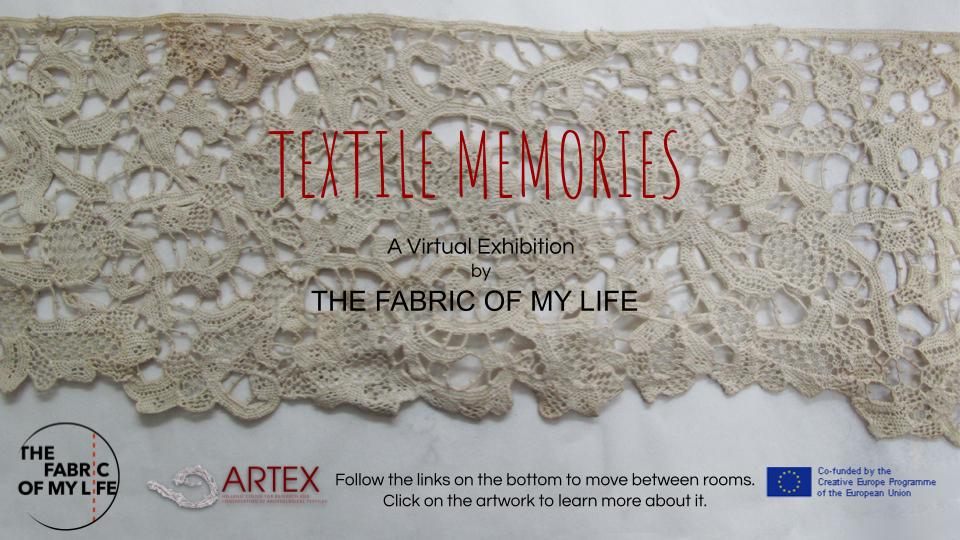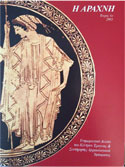TEXTILE MEMORIES - A Virtual Exhibition by THE FABRIC OF MY LIFE

Inspired by textiles and their various techniques, both traditional and innovative, 25 visual artists have created 41 works offering their own approaches and multifaceted interpretations on the subject of memories about migration, textiles and emotions.
All of the artworks in the exhibition revolve around the actual or symbolic iconology of textiles, with themes from the process of weaving itself and all the way to the various uses of the fabrics. The woven cloths appear as common everyday items used to shield and protect the human body, like articles of clothing or bathroom essentials, or in other household uses, such as sleep, dining, and decoration; they also function as symbolic entities, as carriers of collective memories or indicative elements of cultural identity. Along with the physical aspect of the textiles, the process of weaving itself and its therapeutic, spiritual capacities are emphasized as well, thus highlighting the intangible, emotional and mental skills that expand with the creation and use of each fabric.
The artists in the exhibition employ all of these references to the creation and use of textiles in order to voice their concerns on the issue of immigration, to address a major problem of our times and describe their emotions regarding this particular situation. Hence, through their works the viewers can sense the pain of being forced to desert one’s home, the feelings of nostalgia for one’s land and familiar faces, the memories and recollections; at the same time they notice a hint of optimism brought by the recognition that settlement in the new country means hope and new opportunities for the future.
The exhibition can be divided into two main sections:
A) Textile: an object filled with memories
Irini Gonou alludes to our daily interaction with household objects and the emotional load involved in their use, especially when these items are related to the lost homeland.
Voula Karampatzaki figuratively weaves the eternal cycles of life with found items, loaded with human memories, experiences and emotions.
Artemis Alcalay uses either a woven band as a symbol for the ties holding together the members of a displaced family, or an empty garment to convey feelings ranging from the strain of physical absence to the owner’s secret hope for reunification with their loved ones.
Nikitas Bacharas sets up an imaginary, yet genuine, scene from the tough reality of the life of an immigrant. Nevertheless, his images reveal the emotional connection of the woman depicted in his works with an embroidery of great sentimental value for her, a connection that may even be considered a fetish.
Vassia Adamou Vanezi creates a symbolic network of memories in a work involving the active participation of women immigrants and refugees, who have stitched their recollections and wishes on it.
In the works of Yiannis Pappas emblematical pieces of cloth, such as flags, are being shaped and reshaped, taken apart and reconstructed, in the same way people that move from one country to the next are torn away from their homeland, but become reintegrated in different multicultural societies.
Penny Geka interlaces her compositions with readymade items made of fabric, to which she offers a new reality and a new meaning to their existence, thus indirectly hinting at the new reality in the life of immigrants.
Chryssa Voudouroglou uses exclusive items out of cloth from the refugees that came from Asia Minor in 1922, which she proclaims as “emotional relics”, thus alluding both to lost and new homes.
Panagiota Apostolopoulou with her needlework creates a feeling of absence by using simply thread on cloth. She has constructed a game between what is displayed and that which is missing, between real and imaginary, valuable and trivial, public and private, memory and aspiration.
Smaragda Skourta uses thread and mixed media to bring together objects and different materials, in which she incorporates memories, experiences, personal encounters, emotions and other such notions. Hence, she delivers a series of works as a legacy, an ex voto, a pledge to the viewers for the realization of their wishes.
Katerina Kalitsounaki parallels board games to the tremendous adventure in the life of the immigrants and seems deeply perturbed by the perils and ordeals in entails. At the same time she underlines the emotional bond these people have with everyday pieces of cloth and the importance such items have in establishing their social identity.
Kleopatra Tsali employs references from the antiquity to highlight the deep relationship between humans and their clothes, which she attributes to the fact that clothing constitutes some form of shelter and protection.
B) Symbolical references to the movement of populations
Miltos Pantelias depicts the sack or bundle, the object that most typically represents refugee movement and relocation, as a comment on these people are being violently uprooted and forced to relocate carrying only a few belongings.
Panagiota Antonopoulou presents a linear process of the movement of populations and the imprint left on every place the people pass through, their physical presence, as well as their emotions and expectations.
Ianthi Aggelioglou creates an interactive work to take us on a journey through places she has visited and that have left an imprint on her, like most travelling experiences. She has also created an artist book, which functions as a memory chest.
George Petsikopoulos employs the age old myths of the sea and, using the power and symbolism of the color blue indigo, comments on the major issue of immigrants trying to cross the Mediterranean Sea.
Eleni Tzatzalos follows the path of the brief stopovers made by the immigrants during their move, soon after they abandon their homes and before finally settling down, when their memories of the past are still vivid and their hopes for a better future still strong.
Ismini Samanidou and Simon Barker combine weaving techniques with modern digital media to refer to those places we keep well inside our souls, which are inscribed in our memory and define us wherever we may find ourselves.
Ulrikka Mokdad presents the hardships in the life of the immigrants and artfully offers a glimpse at the tragic aspects of the fate of the women among them.
Maria Grigoriou incorporates in her large scale installation the arduous progress of each immigrant, from the mandatory expulsion, the long journey and all the way to the settlement – integration into the new country.
Yiannis Papadopoulos utilizes various creative techniques to discuss the odyssey of the immigrants and communicate the entire impression of their fight for survival in their long road of voluntary or involuntary relocation.
Stavroula Kaziale creates a maze to illustrate the long and arduous course of the life of immigrants and refugees, one filled with obstacles, but also with small personal havens and expectations, leading either to a joyful or to a tragic ending.
Penny Korre honors the memory of those lost in their quest for a new country and a better life, and pays tribute in her own way to those who fought for a brighter future.
Nia Hefe Filiogianni focuses her attention on the continuous migration flows in the Mediterranean Sea, the sea of several ancient civilizations and cultural exchanges.
The works in this exhibition, laden with symbolic meanings and interpretations, have been created using various techniques and an array of mixed media; these include textiles woven on a traditional loom and others on makeshift contraptions, tapestries, needlework done by hand or by sawing machine, sewn on (appliqué) fabrics, patchwork (quilting), embroideries, and the use of natural dyes, painting or digital printing on fabric, aluminum or PVC, sound recordings, digital video. Other materials include paper, salt, natural fibers, thread, fabrics, tulle, burlap, found items, etc.
This visual escapade amongst threads and textiles with distinct conceptual references helps the viewer appreciate the human factor of immigration and understand the hidden aspects of the refugee problem.
Louisa Karapidaki



